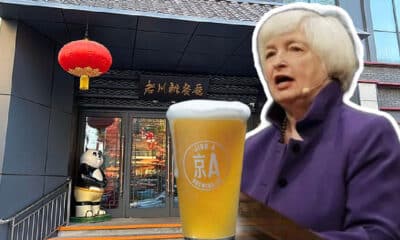China Brands, Marketing & Consumers
China’s Growing e-Commerce Graveyard: These Companies Already Failed in 2017
“When there’s enough wind, even a pig can fly” (当风来了, 猪也会飞起来) does not hold true for all online businesses.
Published
7 years agoon

PREMIUM CONTENT
China’s e-commerce market is a dog-eat-dog world, with new companies popping up every day, while older ones are throwing in the towel. How (not) to make it in China’s crazy world of e-commerce has become a hot topic of discussion on Chinese social media. What’s on Weibo takes a look at 3 big – once successful – Chinese online companies, and why they failed in 2017.
It is still early in the year, but already some big online companies have exited China’s chaotic world of e-commerce. The release of an ‘e-commerce dead list’ (#2017电商死亡名单#) became top trending on Chinese social media on February 22, and triggered discussions on the status-quo of the market.
“One by one they collapse, one by one they pop up,” one netizen (@逛吃秦皇岛) says. With an ever-growing Chinese online population and the world’s largest e-commerce market, more companies seek to join, hoping to find a goldmine. Instead, many of them soon end up on the e-commerce graveyard. The popular idea about China’s e-market that “when there’s enough wind, even a pig can fly” (当风来了, 猪也会飞起来) does not seem to hold true for all online businesses.
Their collapse does not necessarily mean the end – for many, it is just a new beginning. “This whole business is like gambling,” one Weibo commenter responds. Another micro-blogger says: “E-commerce companies all soon become like conventional businesses. The large online companies are just too strong. It is easy to join [the market], but hard to survive.”
Let’s take a look at 3 big companies that have already collapsed this year, and what experts say goes wrong in their approach to the Chinese online market.
“China’s 2017 e-Commerce Dead List”
Along with other Chinese media, China’s influential online e-commerce magazine Ebrun.com recently released a list of big companies that have closed their doors this year. We have selected the 3 biggest ones.
1. Dingfangbao 订房宝

Business: Online Hotel Bookings

With the slogan “You only sleep ten hours, why would you spend all your money for the day on it?” (只睡十小时,为何要花整天的钱), Dingfangbao was an up-and-coming online hotel booking site (app + website) selling high-class hotel rooms at low prices, focused at offering clients a luxurious room for the night.
The company started in late 2014 with its own formula that allowed customers to search for available hotel rooms after 6 pm. Through the Dingfangbao app and site, four and five-star hotels in big cities such as Beijing, Shanghai, Guangzhou, and Shenzhen could offer their rooms at competitive prices if they were not occupied or reserved by 6 pm. A win-win situation: Dingfangbao users could get a top room for a cheap price, and hotels wouldn’t be left with empty hotel rooms.
The Dingfangbao service (Dingfangbao literally meaning ‘booking treasure’) was especially aimed at business travelers who won’t arrive at their hotels until the evenings due to late meetings and leave again early in the morning.
With Japanese nude model/(adult) film actress Sola Aoi (苍井空) as their company ambassador, it seemed that Dingfangbao was also aiming at luring customers to luxurious hotels at nighttime for other purposes – similar to the ‘love hotels’ in Japan.

Japanese sexy actress Sola Aoi was Dingfangbao’s spokesperson.
Dingfangbao had a promising take-off in 2014, with various fundings and an initial angel investment of 6 million RMB (±870K$), followed by second- and third-round funding of a total of 13 million RMB (±1.9M$) in 2015 and 2016.
But on 27 January 2017, Dingfangbao announced that it would be stopping its services. CEO Sun Jianrong (孙建荣) told the media that although there certainly is a market for the Dingbaofang formula, the frequency with which its clients used these services was too low and not enough to cover their operational costs.
On Weibo, the company still has around 19000 followers. Sola Aoi, who has a staggering 17 million fans on her Weibo page, announced on February 8 that she would step down as the company’s spokesperson. A day later, the company officially closed its doors, although its website is still live at the time of writing.
2. Greenbox 绿盒子

Business: O2O Children’s Clothing

Online trendy children’s clothing brand Greenbox (绿盒子) was a success story when it first entered China’s O2O (online-to-offline) retail market in 2010. The company was already established by businesswoman Wu Fangfang (吴芳芳) years before, but it made a conscious shift from offline to e-commerce when Wu realized the potential of middle-class moms spending more time shopping for their kids on the internet.
In 2010, Greenbox received two rounds of funding from Trust Bridge Partners (TBP) of 20 million RMB (3M$), and of 100 million (14.5M$) from DCM. Children clothing brands such as Miss de Mode, M.I.L. Boy, Jenny Bear, and a special Disney brand all belonged to Greenbox, which soon was named one of China’s top 10 e-retailers.
Greenbox tapped into the children’s clothing at the right time, as this retail segment has become especially booming business over the past few years. Together with the surge in other children-related products, there has been a shift to bigger sales of these ‘non-traditional products’ that show that China’s ‘Mummy Economy’ (妈妈经济) has become increasingly more relevant.

Wu Fangfang, the founder of Greenbox.
Soon after the brand was established, it became one of the most popular children’s clothing brands (ranking no.1 for three years in a row) on Alibaba’s online malls Tmall and Taobao. But Greenbox was not solely sold through Alibaba; it was also available through other online shopping platforms such as JD.com and Dangdang. The brand also had its own shop on WeChat.
In 2015, Greenbox started opening up physical stores besides its online ones. It had around 100 (flagship) stores in China’s first-tier cities, solely focused on online sales for the second- and third-tier cities. Was the company taking on more than it could? According to some Chinese media, the brand was “blindly expanding” and growing too fast, too soon, which led to recurring financial difficulties throughout the years. Their financial problems severely worsened in 2016, as the children’s clothing became increasingly competitive. In January 2017, the brand finally announced its bankruptcy.
On Weibo the brand still has 76000 fans, but it has been inactive for months. Some netizens are surprised that the well-known brand has quit, and wonder what this means for the future of other successful ‘Taobao brands.’
3. An Home 安个家

Business: Online Real Estate

An Home (安个家) was established in April of 2015. Headquartered in Shanghai, it was independently funded (10 million RMB, 1.5M$) by CEO Liang Weiping (梁伟平). Its business offered online real estate services with a focus on its mobile app, attempting to rival with traditional real estate services.
Different from offline realtors, An Home aimed to be an online (mobile) platform where its home-seekers, homeowners, and consultants could connect with each other, making the process of buying and selling a house less time-consuming and more efficient.
An Home was a promising start-up for which Liang Weiping gathered a team coming from prosperous companies such as Tencent and Alibaba.
But by late December of 2016, Liang admitted to Chinese media that the company was facing financial hardships, and that they had not succeeded in finding the right way to compete with their offline rivals through online channels. As booming as all corners of China’s e-commerce market might seem, people might not be ready for O2O when it comes to real estate.
One of the reasons for its failure was that eventually, no matter online or offline, access to a large number of houses is the key to winning over the real estate market – and it was precisely this issue where the company feel behind compared to the more traditional channels.
Late 2016, CEO Liang sent out a letter to all of its staff that An Home had to halt operations due to financial difficulties. The company has now closed its doors.
What Can We Learn from the Graveyard Companies?
The aforementioned online companies are not the only ones who did not make it this year. Bollain Home Textile (帛澜家纺天猫店), founded in 2012 and selling bedding and home textiles through over 50 online stores in China, has collapsed after running behind approximately 16 million RMB (2.3M$) in its payments to suppliers and staff.
Online recruitment company Job Tong (周伯通招聘), established in 2013 as a major social recruitment platform and even receiving a 28 million RMB investment from NetEase, also went down earlier this year – its online competitors, including lagou.com, liepin.com, and zhipin.com, simply grew too strong.
“Even the most clever housewife cannot cook without rice”
And then we have not even mentioned foreign brands such as Lotte and others that closed their doors this doors in the highly competitive Chinese e-market.
So what is the lesson to be learned from these start-up failures? Of course, there is not one answer.
But Chinese e-commerce guru Wang Yongjun (王勇军), who has over 2,5 million fans on his Weibo account (@老高电商圈子), thinks he knows what China’s e-commerce start-ups need.
Wang runs a large networking group called the ‘Laogao Club’ for online entrepreneurs in China that are active on Taobao, Tmall, JD.com, etc, and in response to the ‘2017 failing e-commerce list’, published a blog on February 22 in which he gives some main points on how to succeed in this dog-eat-dog e-commerce world.

Mr. Wang, founder of the Laogao Club, explains how businesses can become successful on platforms such as Taobao or JD.com.
According to Wang’s article (in Chinese), which received many views on Weibo on February 22, building up an online community is key for any e-commerce business in China.
“Even the most clever housewife cannot cook without rice”, Wang argues, seeing an online following as the key ingredient to any online-based business. Drawing in communal media followers costs time and energy – haste makes waste.
The ‘guru’ says that online businesses can’t just gather their following by simply arranging a KOL (Key Opinion Leader) or online celebrity (see the first Dingfangbao example) for their brand; it is something a brand has to do themself, since they are the core that needs to attract fans.
“No matter how good you are, or how good your product is, it is worth nothing without an online community.”
“No matter how good you are, or how good your product is, it is worth nothing without an online community,” Wang writes. In a time when netizens are drowning in the information that is presented to them, it is essential that brands and companies are precise in targeting their relevant audiences and shooting their arrows in the right place.
Wang strongly advises companies to set up the right online environment that suits their target audience, and to pick the right timing to market their messages. Sometimes brands are lucky when their campaign goes viral, but mostly it is about smart strategy.
Before converting your assets into cash, it is important to continue to be valuable to followers and give them a reason to stay. Wang stresses that it is never a good idea to start the money-making machine too soon – you first need to make sure you have a steady and loyal group of online followers that is attached to your brand/company.
“Don’t drown the pond to get at the fish.”
“Don’t be overhasty, don’t drain the pond to get to the fish” (不能操之过急、竭泽而渔), is one of the messages of the Laogao Club for their online entrepreneurs. You can only transform your brand and starting making money once your ‘fans’ trust your brand/company enough and feel connected to its ‘flavor.’
Keeping up the quality of your services and products, and always making sure it brings more than just a ‘bargain’, it is therefore key to survive in the fiercely competitive Chinese e-commerce market.
Reading from the Laogao Club’s road to e-success, we could draw the conclusion that Dingfangbao had not worked enough on creating its own communal following of trusting and loyal fans before attempting to converting its assets into cash. An Home jumped into the pond before there were any fish at all, and Greenbox went ahead of itself and became too hasty to expand.
“If you enter the pit, be cautious”, some netizens respond on Weibo: “It is risky business.”
“There are too many people who don’t understand and think they are already running an e-business simply because they openened an online company. It looks good on paper, but in reality, it’s nothing,” another person writes.
– By Manya Koetse
Follow @WhatsOnWeibo
©2017 Whatsonweibo. All rights reserved. Do not reproduce our content without permission – you can contact us at info@whatsonweibo.com.
Manya Koetse is the founder and editor-in-chief of whatsonweibo.com. She is a writer, public speaker, and researcher (Sinologist, MPhil) on social trends, digital developments, and new media in an ever-changing China, with a focus on Chinese society, pop culture, and gender issues. She shares her love for hotpot on hotpotambassador.com. Contact at manya@whatsonweibo.com, or follow on Twitter.

Also Read
China Brands, Marketing & Consumers
Zara Dress Goes Viral in China for Resemblance to Haidilao Apron
Who’s gonna buy this Zara dress in China? “I’m afraid that someone will say I stole the apron from Haidilao.”
Published
1 week agoon
April 19, 2024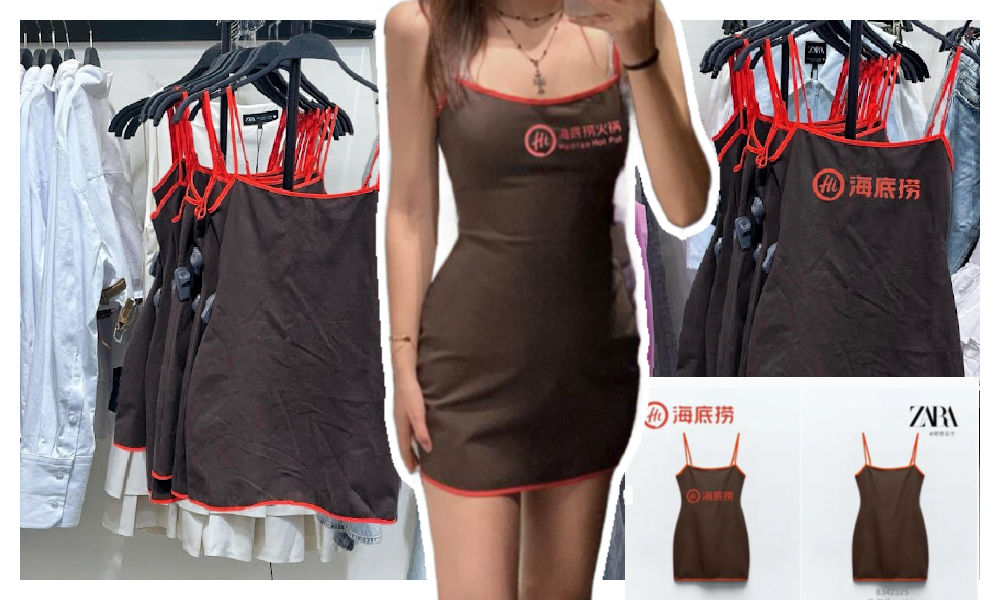
A short dress sold by Zara has gone viral in China for looking like the aprons used by the popular Chinese hotpot chain Haidilao.
“I really thought it was a Zara x Haidialo collab,” some customers commented. Others also agree that the first thing they thought about when seeing the Zara dress was the Haidilao apron.

The “original” vs the Zara dress.
The dress has become a popular topic on Xiaohongshu and other social media, where some images show the dress with the Haidilao logo photoshopped on it to emphasize the similarity.

One post on Xiaohongshu discussing the dress, with the caption “Curious about the inspiration behind Zara’s design,” garnered over 28,000 replies.
Haidilao, with its numerous restaurants across China, is renowned for its hospitality and exceptional customer service. Anyone who has ever dined at their restaurants is familiar with the Haidilao apron provided to diners for protecting their clothes from food or oil stains while enjoying hotpot.
These aprons are meant for use during the meal and should be returned to the staff afterward, rather than taken home.
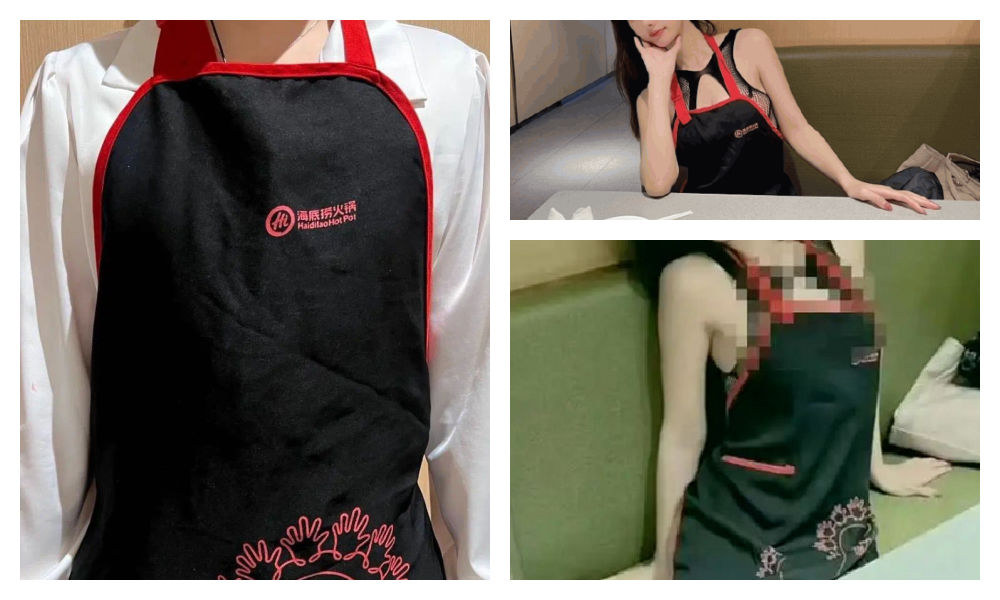
The Haidilao apron.
However, many people who have dined at Haidilao may have encountered the following scenario: after indulging in drinks and hotpot, they realize they are still wearing a Haidilao apron upon leaving the restaurant. Consequently, many hotpot enthusiasts may have an ‘accidental’ Haidilao apron tucked away at home somewhere.
This only adds to the humor of the latest Zara dress looking like the apron. The similarity between the Zara dress and the Haidilao apron is actually so striking, that some people are afraid to be accused of being a thief if they would wear it.
One Weibo commenter wrote: “The most confusing item of this season from Zara has come out. It’s like a Zara x Haidilao collaboration apron… This… I can’t wear it: I’m afraid that someone will say I stole the apron from Haidilao.”

Funnily enough, the Haidilao apron similarity seems to have set off a trend of girls trying on the Zara dress and posting photos of themselves wearing it.

It’s doubtful that they’re actually purchasing the dress. Although some commenters say the dress is not bad, most people associate it too closely with the Haidilao brand: it just makes them hungry for hotpot.
By Manya Koetse
Independently reporting China trends for over a decade. Like what we do? Support us and get the story behind the hashtag by subscribing:
Spotted a mistake or want to add something? Please let us know in comments below or email us. First-time commenters, please be patient – we will have to manually approve your comment before it appears.
©2024 Whatsonweibo. All rights reserved. Do not reproduce our content without permission – you can contact us at info@whatsonweibo.com.
China Brands, Marketing & Consumers
More than Malatang: Tianshui’s Recipe for Success
Zibo had its BBQ moment. Now, it’s Tianshui’s turn to shine with its special take on malatang. Tourism marketing in China will never be the same again.
Published
4 weeks agoon
April 1, 2024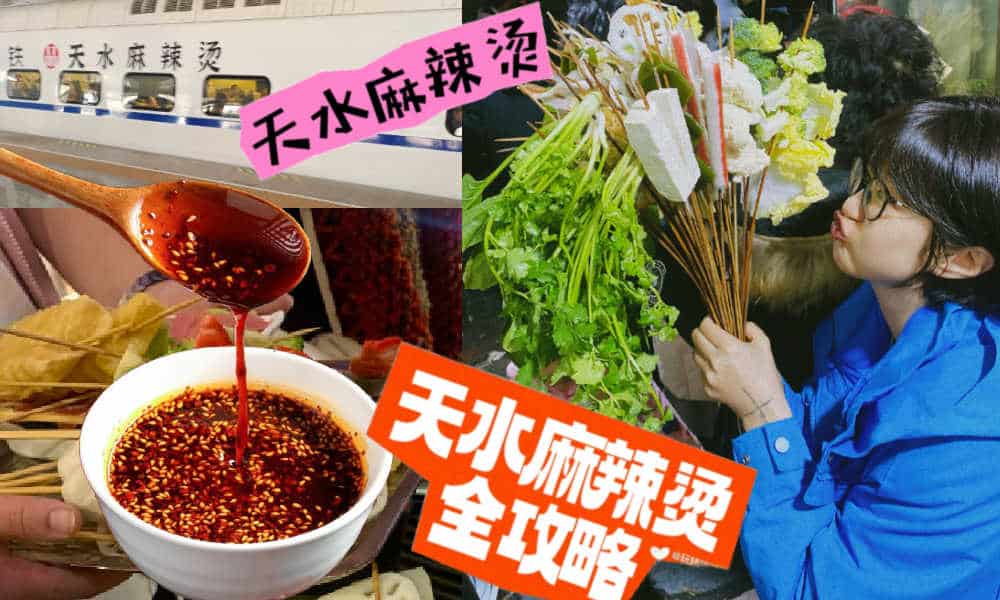
Since the early post-pandemic days, Chinese cities have stepped up their game to attract more tourists. The dynamics of Chinese social media make it possible for smaller, lesser-known destinations to gain overnight fame as a ‘celebrity city.’ Now, it’s Tianshui’s turn to shine.
During this Qingming Festival holiday, there is one Chinese city that will definitely welcome more visitors than usual. Tianshui, the second largest city in Gansu Province, has emerged as the latest travel hotspot among domestic tourists following its recent surge in popularity online.
Situated approximately halfway along the Lanzhou-Xi’an rail line, this ancient city wasn’t previously a top destination for tourists. Most travelers would typically pass through the industrial city to see the Maiji Shan Grottoes, the fourth largest Buddhist cave complex in China, renowned for its famous rock carvings along the Silk Road.
But now, there is another reason to visit Tianshui: malatang.
Gansu-Style Malatang
Málàtàng (麻辣烫), which literally means ‘numb spicy hot,’ is a popular Chinese street food dish featuring a diverse array of ingredients cooked in a soup base infused with Sichuan pepper and dried chili pepper. There are multiple ways to enjoy malatang.
When dining at smaller street stalls, it’s common to find a selection of skewered foods—ranging from meats to quail eggs and vegetables—simmering in a large vat of flavorful spicy broth. This communal dining experience is affordable and convenient for solo diners or smaller groups seeking a hotpot-style meal.
In malatang restaurants, patrons can usually choose from a selection of self-serve skewered ingredients. You have them weighed, pay, and then have it prepared and served in a bowl with a preferred soup base, often with the option to choose the level of spiciness, from super hot to mild.
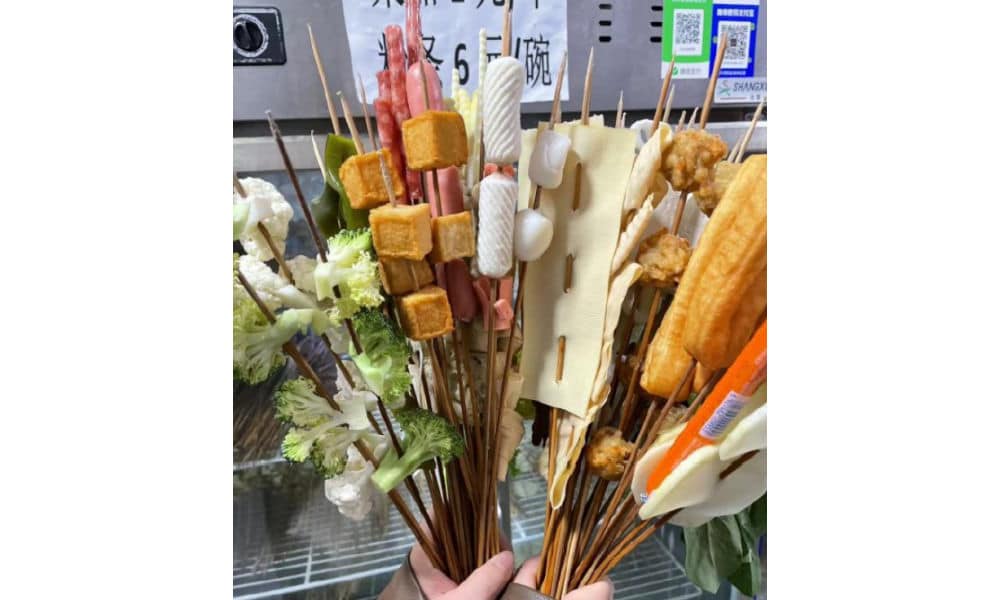
Although malatang originated in Sichuan, it is now common all over China. What makes Tianshui malatang stand out is its “Gansu-style” take, with a special focus on hand-pulled noodles, potato, and spicy oil.
An important ingredient for the soup base is the somewhat sweet and fragrant Gangu chili, produced in Tianshui’s Gangu County, known as “the hometown of peppers.”
Another ingredient is Maiji peppercorns (used in the sauce), and there are more locally produced ingredients, such as the black fungi from Qingshui County.
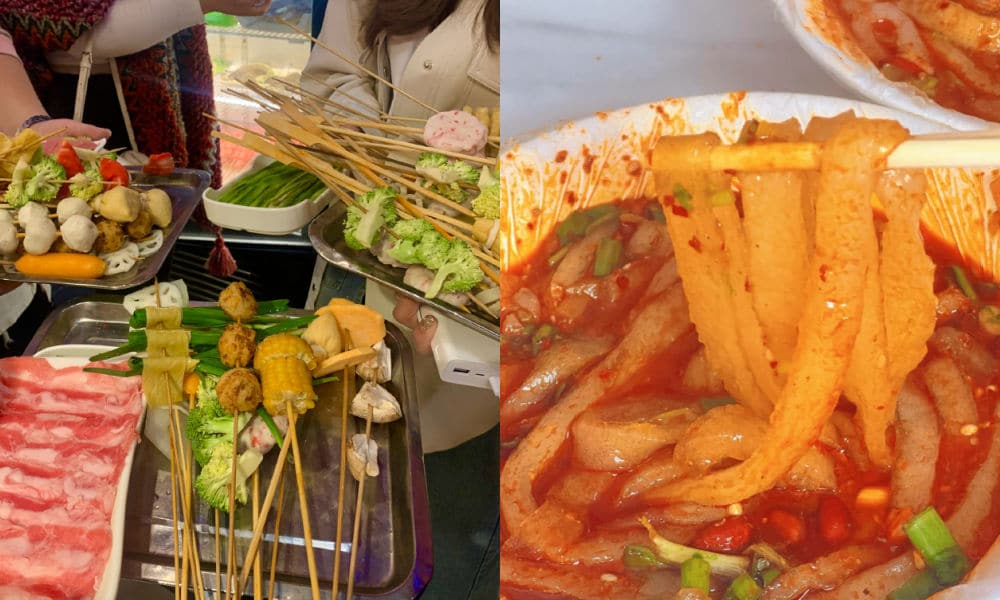
One restaurant that made Tianshui’s malatang particularly famous is Haiying Malatang (海英麻辣烫) in the city’s Qinzhou District. On February 13, the tiny restaurant, which has been around for three decades, welcomed an online influencer (@一杯梁白开) who posted about her visit.
The vlogger was so enthusiastic about her taste of “Gansu-style malatang,” that she urged her followers to try it out. It was the start of something much bigger than she could have imagined.
Replicating Zibo
Tianshui isn’t the first city to capture the spotlight on Chinese social media. Cities such as Zibo and Harbin have previously surged in popularity, becoming overnight sensations on platforms like Weibo, Xiaohongshu, and Douyin.
This phenomenon of Chinese cities transforming into hot travel destinations due to social media frenzy became particularly noteworthy in early 2023.
During the Covid years, various factors sparked a friendly competition among Chinese cities, each competing to attract the most visitors and to promote their city in the best way possible.
The Covid pandemic had diverse impacts on the Chinese domestic tourism industry. On one hand, domestic tourism flourished due to the pandemic, as Chinese travelers opted for destinations closer to home amid travel restrictions. On the other hand, the zero-Covid policy, with its lockdowns and the absence of foreign visitors, posed significant challenges to the tourism sector.
Following the abolition of the zero-Covid policy, tourism and marketing departments across China swung into action to revitalize their local economy. China’s social media platforms became battlegrounds to capture the attention of Chinese netizens. Local government officials dressed up in traditional outfits and created original videos to convince tourists to visit their hometowns.
Zibo was the first city to become an absolute social media sensation in the post-Covid era. The old industrial and mining city was not exactly known as a trendy tourist destination, but saw its hotel bookings going up 800% in 2023 compared to pre-Covid year 2019. Among others factors contributing to its success, the city’s online marketing campaign and how it turned its local BBQ culture into a unique selling point were both critical.

Zibo crowds, image via 163.com.
Since 2023, multiple cities have tried to replicate the success of Zibo. Although not all have achieved similar results, Harbin has done very well by becoming a meme-worthy tourist attraction earlier in 2024, emphasizing its snow spectacle and friendly local culture.
By promoting its distinctive take on malatang, Tianshui has emerged as the next city to captivate online audiences, leading to a surge in visitor numbers.
Like with Zibo and Harbin, one particular important strategy used by these tourist offices is to swiftly respond to content created by travel bloggers or food vloggers about their cities, boosting the online attention and immediately seizing the opportunity to turn online success into offline visits.
A Timeline
What does it take to become a Chinese ‘celebrity city’? Since late February and early March of this year, various Douyin accounts started posting about Tianshui and its malatang.
They initially were the main reason driving tourists to the city to try out malatang, but they were not the only reason – city marketing and state media coverage also played a role in how the success of Tianshui played out.
Here’s a timeline of how its (online) frenzy unfolded:
- July 25, 2023: First video on Douyin about Tianshui’s malatang, after which 45 more videos by various accounts followed in the following six months.
- Feb 5, 2024: Douyin account ‘Chuanshuo Zhong de Bozi’ (传说中的波仔) posts a video about malatang streetfood in Gansu
- Feb 13, 2024: Douyin account ‘Yibei Liangbaikai’ (一杯梁白开) posts a video suggesting the “nationwide popularization of Gansu-style malatang.” This video is an important breakthrough moment in the success of Tianshui as a malatang city.
- Feb – March ~, 2024: The Tianshui Culture & Tourism Bureau is visiting sites, conducting research, and organizing meetings with different departments to establish the “Tianshui city + malatang” brand (文旅+天水麻辣烫”品牌) as the city’s new “business card.”
- March 11, 2024: Tianshui city launches a dedicated ‘spicy and hot’ bus line to cater to visitors who want to quickly reach the city’s renowned malatang spots.
- March 13-14, 2024: China’s Baidu search engine witnesses exponential growth in online searches for Tianshui malatang.
- March 14-15, 2024: The boss of Tianshui’s popular Haiying restaurant goes viral after videos show him overwhelmed and worried he can’t keep up. His facial expression becomes a meme, with netizens dubbing it the “can’t keep up-expression” (“烫不完表情”).

The worried and stressed expression of this malatang diner boss went viral overnight.
- March 17, 2024: Chinese media report about free ‘Tianshui malatang’ wifi being offered to visitors as a special service while they’re standing in line at malatang restaurants.
- March 18, 2024: Tianshui opens its first ‘Malatang Street’ where about 40 stalls sell malatang.
- March 18, 2024: Chinese local media report that one Tianshui hair salon (Tony) has changed its shop into a malatang shop overnight, showing just how big the hype has become.
- March 21, 2024: A dedicated ‘Tianshui malatang’ train started riding from Lanzhou West Station to Tianshui (#天水麻辣烫专列开行#).
- March 21, 2024: Chinese actor Jia Nailiang (贾乃亮) makes a video about having Tianshui malatang, further adding to its online success.
- March 30, 2024: A rare occurrence: as the main attraction near Tianshui, the Maiji Mountain Scenic Area announces that they’ve reached the maximum number of visitors and don’t have the capacity to welcome any more visitors, suspending all ticket sales for the day.
- April 1, 2024: Chinese presenter Zhang Dada was spotted making malatang in a local Tianshui restaurant, drawing in even more crowds.
A New Moment to Shine
Fame attracts criticism, and that also holds true for China’s ‘celebrity cities.’
Some argue that Tianshui’s malatang is overrated, considering the richness of Gansu cuisine, which offers much more than just malatang alone.
When Zibo reached hype status, it also faced scrutiny, with some commenters suggesting that the popularity of Zibo BBQ was a symptom of a society that’s all about consumerism and “empty social spectacle.”
There is a lot to say about the downsides of suddenly becoming a ‘celebrity city’ and the superficiality and fleetingness that comes with these kinds of trends. But for many locals, it is seen as an important moment as they see their businesses and cities thrive.
Even after the hype fades, local businesses can maintain their success by branding themselves as previously viral restaurants. When I visited Zibo a few months after its initial buzz, many once-popular spots marketed themselves as ‘wanghong’ (网红) or viral celebrity restaurants.
For the city itself, being in the spotlight holds its own value in the long run. Even after the hype has peaked and subsided, the gained national recognition ensures that these “trendy” places will continue to attract visitors in the future.
According to data from Ctrip, Tianshui experienced a 40% increase in tourism spending since March (specifically from March 1st to March 16th). State media reports claim that the city saw 2.3 million visitors in the first three weeks of March, with total tourism revenue reaching nearly 1.4 billion yuan ($193.7 million).
There are more ripple effects of Tianshui’s success: Maiji Shan Grottoes are witnessing a surge in visitors, and local e-commerce companies are experiencing a spike in orders from outside the city. Even when they’re not in Tianshui, people still want a piece of Tianshui.
By now, it’s clear that tourism marketing in China will never be the same again. Zibo, Harbin, and Tianshui exemplify a new era of destination hype, requiring a unique selling point, social media success, strong city marketing, and a friendly and fair business culture at the grassroots level.
While Zibo’s success was largely organic, Harbin’s was more orchestrated, and Tianshui learned from both. Now, other potential ‘celebrity’ cities are preparing to go viral, learning from the successes and failures of their predecessors to shine when their time comes.
By Manya Koetse
Independently reporting China trends for over a decade. Like what we do? Support us and get the story behind the hashtag by subscribing:
Spotted a mistake or want to add something? Please let us know in comments below or email us. First-time commenters, please be patient – we will have to manually approve your comment before it appears.
©2024 Whatsonweibo. All rights reserved. Do not reproduce our content without permission – you can contact us at info@whatsonweibo.com.
Subscribe

Weibo Watch: The Battle for the Bottom Bed

Zara Dress Goes Viral in China for Resemblance to Haidilao Apron

“Old Bull Eating Young Grass”: 86-Year-Old Chinese Painter Fan Zeng Marries 36-Year-Old Xu Meng

Chengdu Disney: The Quirkiest Hotspot in China

Where to Eat and Drink in Beijing: Yellen’s Picks

The ‘Two Sessions’ Suggestions: Six Proposals Raising Online Discussions

Top 9 Chinese Movies to Watch This Spring Festival Holiday

Party Slogan, Weibo Hashtag: “The Next China Will Still Be China”

From Pitch to Politics: About the Messy Messi Affair in Hong Kong (Updated)

Looking Back on the 2024 CMG Spring Festival Gala: Highs, Lows, and Noteworthy Moments

Two Years After MU5735 Crash: New Report Finds “Nothing Abnormal” Surrounding Deadly Nose Dive

More than Malatang: Tianshui’s Recipe for Success

“Old Bull Eating Young Grass”: 86-Year-Old Chinese Painter Fan Zeng Marries 36-Year-Old Xu Meng

Chengdu Disney: The Quirkiest Hotspot in China

In Hot Water: The Nongfu Spring Controversy Explained
Get in touch
Would you like to become a contributor, or do you have any tips or suggestions? Get in touch here!
Popular Reads
-

 China Insight2 months ago
China Insight2 months agoThe ‘Two Sessions’ Suggestions: Six Proposals Raising Online Discussions
-

 China Arts & Entertainment3 months ago
China Arts & Entertainment3 months agoTop 9 Chinese Movies to Watch This Spring Festival Holiday
-

 China Media2 months ago
China Media2 months agoParty Slogan, Weibo Hashtag: “The Next China Will Still Be China”
-

 China World2 months ago
China World2 months agoFrom Pitch to Politics: About the Messy Messi Affair in Hong Kong (Updated)


